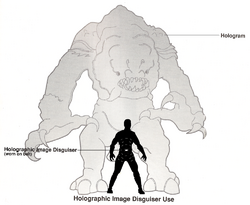Holographic image disguiser: Difference between revisions
imported>RoboCade m Removing TC'd audiobooks |
imported>PastaBot m Template fixes |
||
| Line 10: | Line 10: | ||
*''[[Boba Fett: A New Threat]]'' | *''[[Boba Fett: A New Threat]]'' | ||
*''[[Jedi Trial]]'' | *''[[Jedi Trial]]'' | ||
* | *{{Shortstory|story=Doctor Death: The Tale of Dr. Evazan and Ponda Baba|book=Tales from the Mos Eisley Cantina}} {{1st}} | ||
*{{Journal|15|The Great Herdship Heist}} {{Mo}} | *{{Journal|15|The Great Herdship Heist}} {{Mo}} | ||
*{{SWG|An Empire Divided}} | *{{SWG|An Empire Divided}} | ||
Latest revision as of 18:31, 24 August 2022

A holographic image disguiser (also known as a holoshroud) was a highly advanced, and very expensive, portable holoprojector that could be used to disguise an existing object or person. A standard model such as the Corellidyne CQ-3.9x holographic image disguiser was small enough to be worn on a belt, though its low memory capacity prohibited it from storing more than a single image, and its power supply was exhausted after only two minutes, unless it was attached to a larger source. Another model was the CQ-3.99 holographic image disguiser.
When in use, a holoshroud projected a mostly pre-rendered image over the target; the image had to be at least the same size as the target object or larger for obvious reasons. The high-quality image was incredibly realistic; capable of fooling the unaided eye, it even moved when the object or person did. However, some models had a tell-tale "flicker" to them; while too fast for the normal eye to perceive, it may allow some droids, cameras and other sensors to detect that something was amiss.
Appearances
 Star Wars: The Clone Wars – "Holocron Heist"
Star Wars: The Clone Wars – "Holocron Heist"- Boba Fett: A New Threat
- Jedi Trial
- "Doctor Death: The Tale of Dr. Evazan and Ponda Baba"—Tales from the Mos Eisley Cantina (First appearance)
 "The Great Herdship Heist" – Star Wars Adventure Journal 15 (Mentioned only)
"The Great Herdship Heist" – Star Wars Adventure Journal 15 (Mentioned only)- File:SWG logo sm.png Star Wars Galaxies: An Empire Divided
- Young Jedi Knights: Shadow Academy
- Young Jedi Knights: Lightsabers
- Young Jedi Knights: Darkest Knight
- The New Jedi Order: Star by Star
- The New Jedi Order: Enemy Lines I: Rebel Dream (Mentioned only)
- Legacy of the Force: Invincible (Indirect mention only)
Sources
- Arms & Equipment Guide
- Scavenger's Guide to Droids
- Scum and Villainy
- Star Wars Encyclopedia
- The Essential Guide to Weapons and Technology
- The Force Unleashed Campaign Guide
- The Complete Star Wars Encyclopedia
 Evazan, Doctor in the Databank (content now obsolete; backup link)
Evazan, Doctor in the Databank (content now obsolete; backup link)